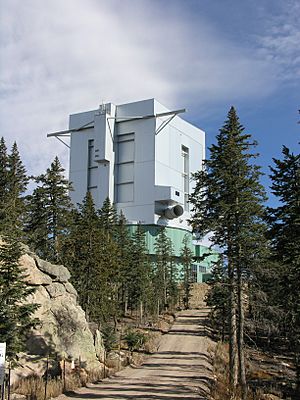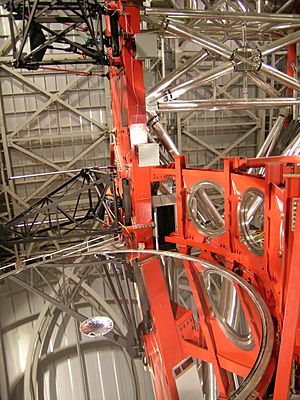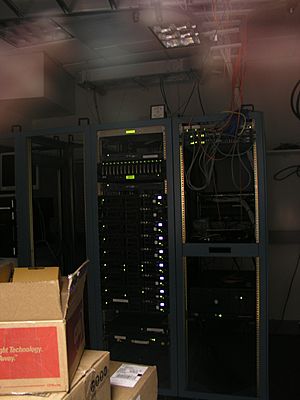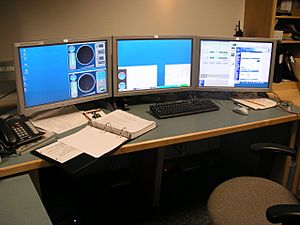Large Binocular Telescope facts for kids
The Large Binocular Telescope (LBT) is a special kind of optical telescope used by astronomers to study space. It's located high up on Mount Graham in southeastern Arizona, United States. This mountain is part of the Mount Graham International Observatory, which has several telescopes.
The LBT is unique because it uses two very large mirrors, each 8.4 meters (about 27.5 feet) wide. These mirrors are placed 14.4 meters (about 47 feet) apart on the same base. When they work together, the LBT can collect as much light as a single telescope 11.8 meters (about 38.7 feet) wide. This means it can see very faint objects in space. It also has the sharpness of a telescope 22.8 meters (about 75 feet) wide, which helps it see incredibly clear details.
Each of the LBT's mirrors is one of the largest single, non-segmented mirrors in any optical telescope in North America. This means the mirrors are made from one solid piece of glass, not many smaller pieces joined together.
Contents
Building the Telescope
The LBT project was first called the "Columbus Project." Many different groups from around the world worked together to build it. These partners include astronomers from Italy, several universities in the United States (like the University of Arizona and Ohio State University), and research institutes in Germany. Building this amazing telescope cost about 100 million Euros.
The telescope was designed to have two huge 8.4-meter mirrors on one shared base. This is why it's called "binocular," like a pair of binoculars. The LBT also uses advanced technology called active optics and adaptive optics. These systems help correct any blurriness caused by Earth's atmosphere, making the images much clearer.
The total area that collects light from space is about 111 square meters (1,190 square feet). This is like having a single telescope with an 11.8-meter (38.7-foot) wide mirror. The telescope was built by a group of Italian companies.
First Views of Space
The Large Binocular Telescope was officially opened in October 2004. It saw its "first light" (meaning its first images of space) with one mirror on October 12, 2005. The first object it viewed was a galaxy called NGC 891.
The second mirror was put in place in January 2006. Both mirrors were fully working together by January 2008. The first images taken with both mirrors working together were of a spiral galaxy called NGC 2770. This galaxy is about 88 million light-years away from our Milky Way galaxy.
The first images of NGC 2770 were shown in different colors to highlight various features:
- One image used ultraviolet and green light to show bright, clumpy areas where new, hot stars were forming.
- Another image used deep red colors to show older, cooler stars spread more smoothly throughout the galaxy.
- A third image combined all these colors to show a detailed picture of the galaxy's stars.
These first images were captured by the Large Binocular Camera team. When both mirrors work together in a special "aperture synthesis" mode, the LBT can create images as sharp as those from a single 22.8-meter (75-foot) telescope.
Adaptive Optics
In 2010, the LBT started using a new system called "First Light Adaptive Optics" (FLAO). This system is very clever because it uses a special flexible secondary mirror to correct distortions caused by Earth's atmosphere. Imagine looking at something through wavy water – adaptive optics makes the water still so you can see clearly.
With this system, the LBT can take images that are even sharper than those from the Hubble Space Telescope at certain light wavelengths. This technology helps astronomers get incredibly clear views of distant objects in space.
LBT in the Media
The Large Binocular Telescope has been featured on several TV shows and radio programs. It appeared on the Discovery Channel show Really Big Things, the National Geographic Channel's Big, Bigger, Biggest, and the BBC program The Sky At Night. It was also discussed in a BBC Radio 4 documentary called The New Galileos.
Discoveries and Observations
The LBT has helped astronomers make exciting discoveries:
- In 2008, working with another telescope called XMM-Newton, the LBT helped discover a galaxy cluster named 2XMM J083026+524133. This cluster is more than 7 billion light-years away!
- In 2007, the LBT detected the faint glow left behind after a powerful gamma-ray burst called GRB 070125.
- In 2017, the LBT even observed the OSIRIS-REx spacecraft, which is a robotic probe sent to collect samples from an asteroid, while it was traveling through space.
Telescope Instruments
The LBT uses many different instruments to study space. Each instrument is designed for a specific type of observation:
- LBC: These are cameras that take wide-field pictures in visible and near-ultraviolet light. One camera is good for blue light, and another for red light.
- MODS: These are spectrographs that can split light into its different colors, like a prism. This helps scientists learn what distant objects are made of.
- LUCI: These are infrared spectrographs and imagers. They work in the near-infrared part of the light spectrum and can take images and analyze light in both normal and super-sharp (with adaptive optics) modes. LUCI operates at very cold temperatures, about -200°C.
- FLAO: This is the "First Light Adaptive Optics" system that corrects for atmospheric blur.
- ARGOS: This system uses multiple lasers to create artificial "guide stars" in the atmosphere. These guide stars help the adaptive optics system work even better.
LUCI
LUCI is a very important instrument for the LBT. It was originally called LUCIFER, but its name was changed to LUCI in 2012. LUCI helps astronomers study objects in the near-infrared part of the light spectrum (0.9–2.5 micrometers). It can take both images and spectroscopic data, which means it can see what elements are present in distant stars and galaxies. LUCI is kept extremely cold, at about -200°C, inside a special container called a cryostat.
LBT Partners
The Large Binocular Telescope is a big project with many partners from different countries:
- Arizona, USA (25% share)
- University of Arizona (main headquarters)
- Arizona State University
- Northern Arizona University
- Germany (25% share)
- Heidelberg-Königstuhl State Observatory
- Leibniz Institute for Astrophysics Potsdam
- Max Planck Institute for Astronomy
- Max Planck Institute for Extraterrestrial Physics
- Max Planck Institute for Radio Astronomy
- Italy (25% share)
- Research Corporation for Science Advancement, USA (12.5% share)
- The Ohio State University, Ohio, USA (12.5% share)
Other Telescopes at Mount Graham
The Mount Graham International Observatory is home to other important telescopes besides the LBT:
- Mount Graham Submillimeter Telescope
- Vatican Advanced Technology Telescope
Images for kids
See also
 In Spanish: Gran telescopio binocular para niños
In Spanish: Gran telescopio binocular para niños
- Extremely large telescope
- List of astronomical interferometers at visible and infrared wavelengths
- List of largest optical reflecting telescopes
- List of largest optical telescopes historically
- List of largest optical telescopes in the continental United States
- Lists of telescopes
- Mount Graham International Observatory
- Navigator Program
- Richard Green (astronomer)
- Safford, Arizona






